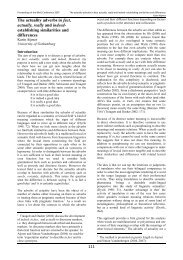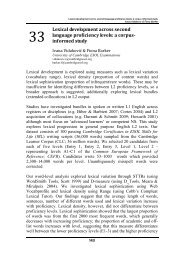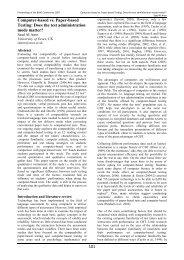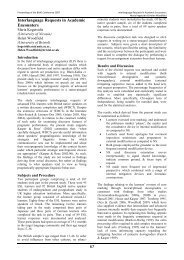Proceedings of the - British Association for Applied Linguistics
Proceedings of the - British Association for Applied Linguistics
Proceedings of the - British Association for Applied Linguistics
You also want an ePaper? Increase the reach of your titles
YUMPU automatically turns print PDFs into web optimized ePapers that Google loves.
21<br />
105<br />
Communicating Strategically in Spanish as L2<br />
Maritza Rosas Maldonado<br />
Communicating Strategically in Spanish<br />
as L2<br />
Maritza Rosas Maldonado<br />
University <strong>of</strong> Liverpool<br />
maritza.rosas@liv.ac.uk<br />
One area <strong>of</strong> language learning in which <strong>Applied</strong> <strong>Linguistics</strong> has made an<br />
important contribution is in extending our understanding <strong>of</strong> <strong>the</strong> important<br />
role <strong>of</strong> Communication Strategies (CSs). This term refers to <strong>the</strong> different<br />
mechanisms L2 learners apply to overcome difficulties encountered in<br />
communicating. However, research has not thoroughly examined CSs in<br />
interactional contexts and has focused mainly on lexical problems and<br />
English as L2. This paper, which presents work in progress, examines <strong>the</strong><br />
way in which English L2 learners <strong>of</strong> Spanish use CSs in communicating<br />
face-to-face with o<strong>the</strong>r learners (NNSs) and native speakers (NSs) <strong>of</strong><br />
Spanish. The final aim is to investigate CSs and <strong>the</strong>ir possible contribution<br />
to learners’ successful communication.<br />
Learners with two different pr<strong>of</strong>iciency levels interacted face-to-face in<br />
dyads <strong>of</strong> NNS-NNS and NNS-NS per<strong>for</strong>ming two types <strong>of</strong> tasks: a closed<br />
task (a jigsaw activity) and an open task (a free-conversation activity). Both<br />
tasks were selected from a pilot study previously conducted and which<br />
aimed at finding <strong>the</strong> best methodology <strong>for</strong> <strong>the</strong> collection <strong>of</strong> data <strong>for</strong> this<br />
larger research. A total <strong>of</strong> 36 interactions with different combinations <strong>of</strong><br />
dyad and task were elicited by means <strong>of</strong> video and audio recording,<br />
observation <strong>of</strong> participants’ interactions and stimulated recall methodology.<br />
For <strong>the</strong> subsequent analysis, <strong>the</strong> tasks per<strong>for</strong>med by <strong>the</strong> participants and<br />
<strong>the</strong>ir retrospective comments were transcribed using <strong>the</strong> s<strong>of</strong>tware Transana<br />
(Woods & Fassnacht, 2005). This data was <strong>the</strong>n examined using <strong>the</strong><br />
<strong>the</strong>oretical framework proposed by Dӧrnyei & Kӧrmos (1998), and <strong>the</strong><br />
interactional and paralinguistic CSs presented in a previous review on <strong>the</strong>se<br />
strategies by Dӧrnyei & Scott (1995). In order to carry out this analysis and<br />
be able to identify <strong>the</strong> greatest number <strong>of</strong> mechanisms possible, a<br />
categorisation <strong>of</strong> <strong>the</strong> different ways <strong>of</strong> identifying <strong>the</strong> CSs was devised.<br />
This classification constituted <strong>the</strong> coding scheme that was set up with <strong>the</strong><br />
s<strong>of</strong>tware used <strong>for</strong> <strong>the</strong> analysis, <strong>the</strong> UAM corpus tool (O’Donnell, 2007). As<br />
a final procedure a one-to-one inter-rater reliability test was carried out to<br />
assess and validate results and reduce <strong>the</strong> researcher’s bias.







